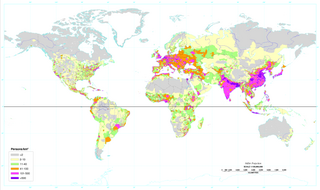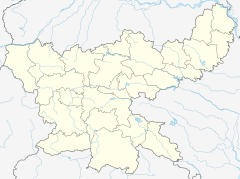
Area 51 is the common name of a highly classified United States Air Force (USAF) facility located within the Nevada Test and Training Range. The facility is officially called Homey Airport (KXTA) or Groom Lake, named after the salt flat situated next to its airfield. Details of the facility's operations are not publicly known, but the USAF says that it is an open training range, and it most likely supports the development and testing of experimental aircraft and weapons systems. The USAF acquired the site in 1955, primarily for flight testing the Lockheed U-2 aircraft.
Federal Information Processing Standards (FIPS) are publicly announced standards developed by the National Institute of Standards and Technology for use in computer systems by non-military American government agencies and government contractors.

A ZIP Code is a postal code used by the United States Postal Service (USPS). Introduced in 1963, the basic format consists of five digits. In 1983, an extended ZIP+4 code was introduced; it includes the five digits of the ZIP Code, followed by a hyphen and four digits that designate a more specific location.

A metropolitan area is a region consisting of a densely populated urban core and its less-populated surrounding territories, sharing industry, infrastructure, and housing. A metro area usually comprises multiple jurisdictions and municipalities: neighborhoods, townships, boroughs, cities, towns, exurbs, suburbs, counties, districts, states, and even nations like the eurodistricts. As social, economic and political institutions have changed, metropolitan areas have become key economic and political regions.

Population density is a measurement of population per unit area, or exceptionally unit volume; it is a quantity of type number density. It is frequently applied to living organisms, most of the time to humans. It is a key geographical term. In simple terms, population density refers to the number of people living in an area per square kilometre.

In law, an unincorporated area is a region of land that is not governed by a local municipal corporation; similarly an unincorporated community is a settlement that is not governed by its own local municipal corporation, but rather is administered as part of larger administrative divisions, such as a township, parish, borough, county, city, canton, state, province or country. Occasionally, municipalities dissolve or disincorporate, which may happen if they become fiscally insolvent, and services become the responsibility of a higher administration. Widespread unincorporated communities and areas are a distinguishing feature of the United States and Canada. In most other countries of the world, there are either no unincorporated areas at all, or these are very rare; typically remote, outlying, sparsely populated or uninhabited areas.
A census-designated place (CDP) is a concentration of population defined by the United States Census Bureau for statistical purposes only. CDPs have been used in each decennial census since 1980 as the counterparts of incorporated places, such as self-governing cities, towns, and villages, for the purposes of gathering and correlating statistical data. CDPs are populated areas that generally include one officially designated but currently unincorporated community, for which the CDP is named, plus surrounding inhabited countryside of varying dimensions and, occasionally, other, smaller unincorporated communities as well. CDPs include small rural communities, colonias located along the Mexico–United States border, and unincorporated resort and retirement communities and their environs.

The New York metropolitan area is the largest metropolitan area in the world by urban landmass, at 3,450.2 sq mi (8,936 km2). The metropolitan area includes New York City, Long Island, and the Mid and Lower Hudson Valley in the state of New York; the five largest cities in New Jersey: Newark, Jersey City, Paterson, Elizabeth, and Edison, and their vicinities; and six of the seven largest cities in Connecticut: Bridgeport, New Haven, Stamford, Waterbury, Norwalk, and Danbury, and their vicinities.

The North American Central Time Zone (CT) is a time zone in parts of Canada, the United States, Mexico, Central America, some Caribbean Islands, and part of the Eastern Pacific Ocean.
A telephone numbering plan is a type of numbering scheme used in telecommunication to assign telephone numbers to subscriber telephones or other telephony endpoints. Telephone numbers are the addresses of participants in a telephone network, reachable by a system of destination code routing. Telephone numbering plans are defined in each of administrative regions of the public switched telephone network (PSTN) and they are also present in private telephone networks. For public number systems, geographic location plays a role in the sequence of numbers assigned to each telephone subscriber.

An urban area, or built-up area, is a human settlement with a high population density and infrastructure of built environment. Urban areas are created through urbanization and are categorized by urban morphology as cities, towns, conurbations or suburbs. In urbanism, the term contrasts to rural areas such as villages and hamlets; in urban sociology or urban anthropology it contrasts with natural environment. The creation of early predecessors of urban areas during the urban revolution led to the creation of human civilization with modern urban planning, which along with other human activities such as exploitation of natural resources led to a human impact on the environment. "Agglomeration effects" are in the list of the main consequences of increased rates of firm creation since. This is due to conditions created by a greater level of industrial activity in a given region. However, a favorable environment for human capital development would also be generated simultaneously.

The San Francisco Bay Area, popularly referred to as the Bay Area or simply the Bay, is a populous region surrounding the San Francisco, San Pablo, and Suisun Bay estuaries in Northern California. Although the exact boundaries of the region vary depending on the source, the Bay Area is defined by the Association of Bay Area Governments to include the nine counties that border the aforementioned estuaries: Alameda, Contra Costa, Marin, Napa, San Mateo, Santa Clara, Solano, Sonoma, and San Francisco. Other sources may exclude parts of or even entire counties, or expand the definition to include neighboring counties that do not border the bay such as San Benito, San Joaquin, and Santa Cruz.










